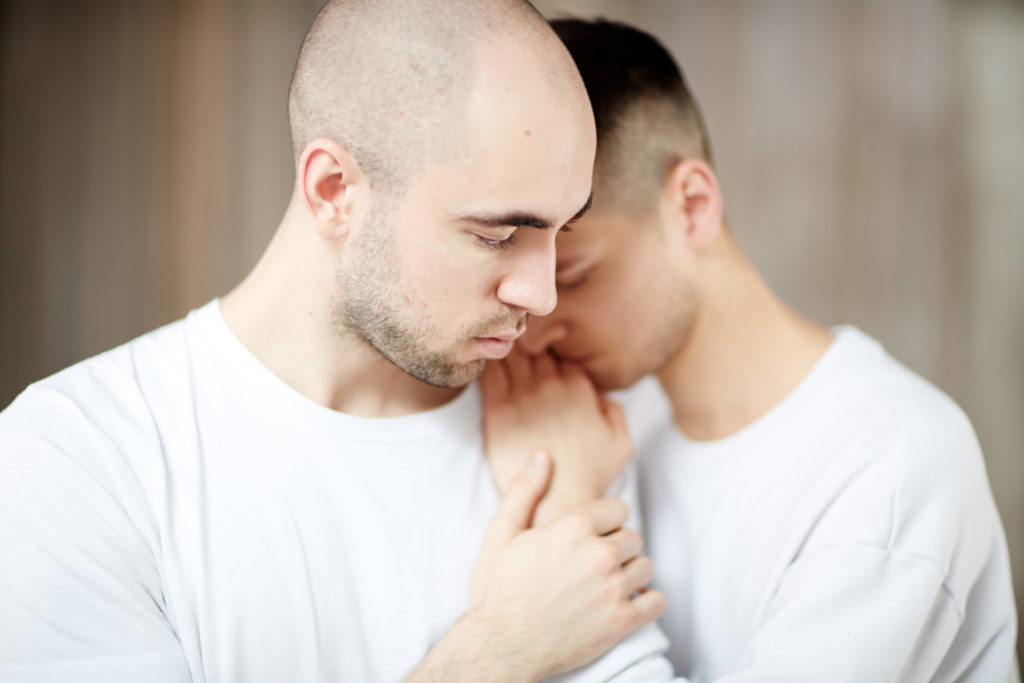May is Mental Health Awareness Month. To commemorate it, we’re taking a closer look at LGBTQ mental health.
People who identify as gay, lesbian, or bisexual (LGB) are two to three times more likely to have long-term psychological or emotional issues than heterosexual people.
As if that weren’t bad enough, mental health issues put them at greater risk for substance abuse. Indeed, an estimated 20 to 30 percent of LGBTQ people abuse substances, compared with 9 percent of the total population.
In honor of Mental Health Awareness Month, we’re taking a closer look at the connection between LGBTQ mental health and substance abuse. Read on to learn why this population struggles more with both issues and to see some solutions.
Mental Health In The LGBTQ Population
To say there’s a mental health crisis in the LGBTQ population would be putting it lightly. LGB adults are more than twice as likely as heterosexual adults to experience a mental health condition. And transgender individuals are nearly four times as likely as cisgender individuals to experience a mental health condition.
The same patterns hold true for LGB youth. Members of this group are more than twice as likely to report persistent feelings of sadness or hopelessness than their heterosexual peers.
Transgender youth have even worse outcomes. They’re twice as likely to experience depressive symptoms, seriously consider suicide, and attempt suicide compared to cisgender lesbian, gay, bisexual, and queer youth.
Read on to learn about the socioeconomic and cultural conditions negatively impacting mental health in the LGBTQ community.
LGBTQ Mental Health Risk Factors
LGBTQ people face a variety of mental health risk factors that straight, cis-gendered individuals don’t have to deal with. This is especially true for LGBTQ people of color and transgender folx.
Let’s look at these risk factors in more depth.
Coming Out
Each year LGBTQ people gain more and more societal acceptance. And study after study has found that a more accepting society acts as a protective factor for mental health. Still, this shift isn’t necessarily all good news.
Shifting attitudes have meant that many LGBTQ adolescents come out during younger developmental stages, impacting their social experiences and relationships in ways previously unobserved. While coming out earlier may provide protection (especially when it comes to depression and anxiety), it may have the opposite effect for youth in unsupportive environments.
Rejection
Those who choose to come out may find the process difficult or even traumatic. That’s especially true for an LGBTQ person whose family, friends, or collegues reject them.
This happens more often than we’d like to think. In fact, according to a 2013 survey, 40% of LGBT adults have experienced rejection from a family member or a close friend. In addition, a 2019 school climate survey showed that 86% of LGBTQ youth reported harassment or assault at school, both of which are risk factors for mental health.
Homelessness
Homelessness is a huge problem for LGBTQ youth and young adults. Many lose their homes due to family rejection or discrimination of their gender identity and/or sexual orientation. As a whole, this group has a 120% higher risk of homelessness than their straight or cisgender peers.
What’s more, young members of the LGBTQ community face the added challenge of finding homeless shelters that will accept them. They may also experience elevated rates of harassment and abuse if they do manage to enter these spaces.
Trauma
Trauma comes in many forms and looks different for everyone. That being said, many LGBTQ people experience similar traumas. Bullying, feelings of shame, and homo/bi/transphobia are common sources of trauma in this group.
In addition, the LGBTQ community faces various forms of discrimination including labeling, stereotyping, denial of opportunities or access, and verbal, mental, and physical abuse.
What’s more, they’re one of the most targeted communities by perpetrators of hate crimes in the United States. This form of discrimination puts LGBTQ people at a heightened risk for post-traumatic stress disorder (PTSD).
Suicide
Suicide is yet another risk factor impacting LGBTQ mental health. Not only is the LGBTQ population at a higher risk for suicidal thoughts and suicide attempts, but LGB high school students are more than four times as likely to have attempted suicide compared to their heterosexual peers. For transgender adults, the situation is dire. Some 40 percent of trans adults have attempted suicide in their lifetime, compared to less than 5% of the general U.S. population.
Inadequate Mental Health Care
Access to mental health care is problematic for the general population but almost non-existent for LGBTQ people. Indeed, one study found that only 12 percent of treatment programs mention being LGBTQ-friendly.
Already this number is pretty low, but it gets worse. When asked about any special provisions for LGBTQ clients, only 7.4 percent were able to give specific examples. Most simply restated their commitment to inclusivity.
When it comes to mental health care, LGBTQ people have unique needs and require specialized treatment. Very few practitioners have even basic training in working with LGBTQ clients. The result is inadequate care and poorer treatment outcomes.
Substance Use
Substance misuse or overuse is an often-used coping mechanism for members of the LGBTQ community. In fact, LGB adults are nearly twice as likely as heterosexual adults to experience a substance use disorder. Transgender individuals are almost four times as likely as cisgender individuals to experience a substance use disorder.

Solutions For Improving LGBTQ Mental Health
Improving LGBTQ mental health isn’t easy. It’s a challenge that will take time and one that must be attacked from multiple angles.
Short-Term Solutions
In the short term, get involved with Mental Health Awareness Month this year. By raising awareness about mental health, you can help reduce the stigma, provide support, and advocate for better policies.
Here are some suggestions:
- Reading the National Alliance on Mental Illness (NAMI) blog.
- Sharing your own mental health challenges with friends, family, or online.
- Contacting your local and state legislators about upcoming bills associated with mental health access, awareness, and treatment.
- Sharing awareness information, images, and graphics on social media.
- Reaching out to your LGBTQ friends and family members to let them know you love and support them.
Long-Term Solutions
Looking to the future, many things can improve. For starters, doctors and other medical personnel should receive LGBTQ-specific training. For now, many lack this kind of training and are thus less effective when it comes to getting LGBTQ people the help they need.
A second improvement would be more funding and incentives for research about LGBTQ mental health. As things stand now, no major federal funding exists to support research on LGBTQ mental health issues. Consequently, there’s a lack of accurate and comprehensive data on the mental health needs of this group.
Another improvement would be better-integrated mental health and substance abuse treatment programs. These programs, also known as dual-diagnosis programs, treat both conditions at the same time and have proven more effective than traditional programs.
La Fuente Celebrates LGBTQ Mental Health Awareness Month
As a treatment center serving only LGBTQ clients, we do everything we can to advocate for greater mental health awareness in the LGBTQ community. Similarly, we recognize that members of our community may be hesitant to get help for mental health issues or substance abuse because of the lack of available resources or because of the stigma associated with being LGBTQ.
That’s why we’re dedicated to providing a safe, judgment-free space for LGBTQ people. In addition, we provide tailored treatment plans at our Los Angeles addiction treatment center.
If you or a loved one is struggling with a substance abuse disorder, now is the time to seek help. Fill out the form below. We’ll contact you in 24 hours or less to discuss your specific needs.





